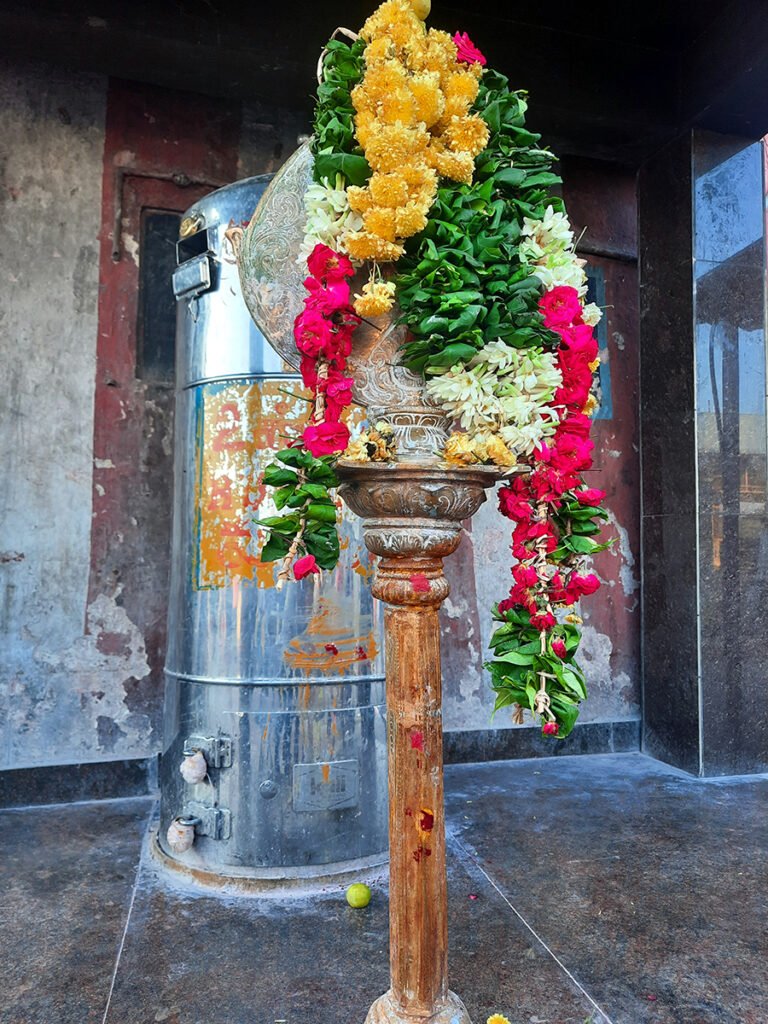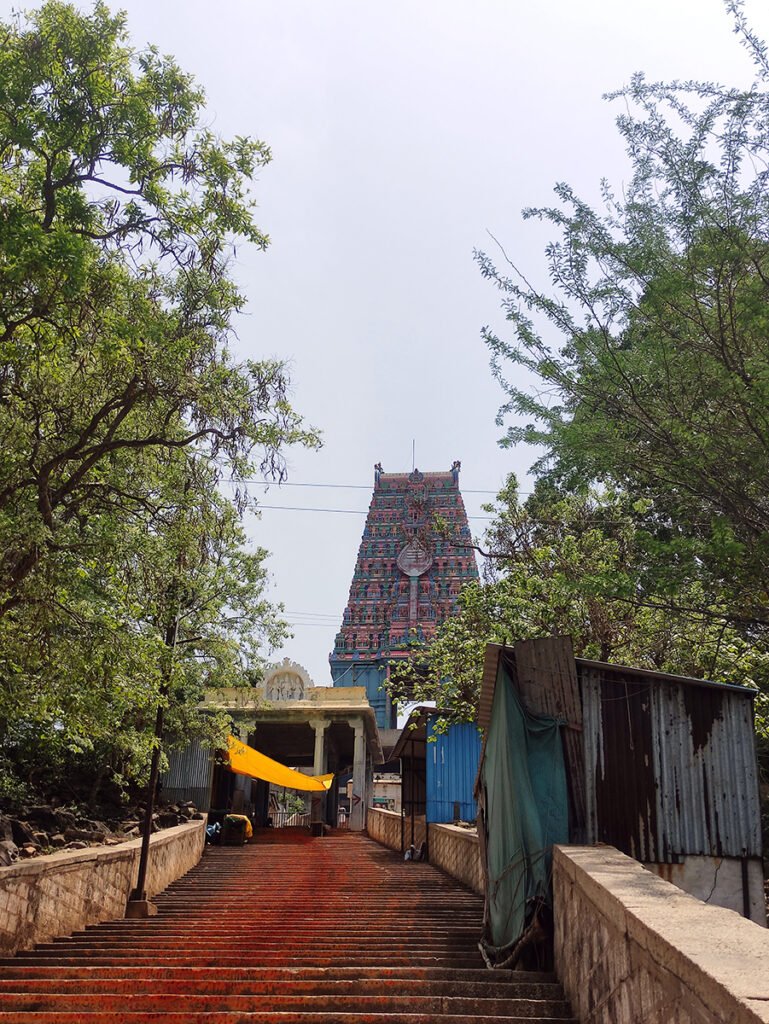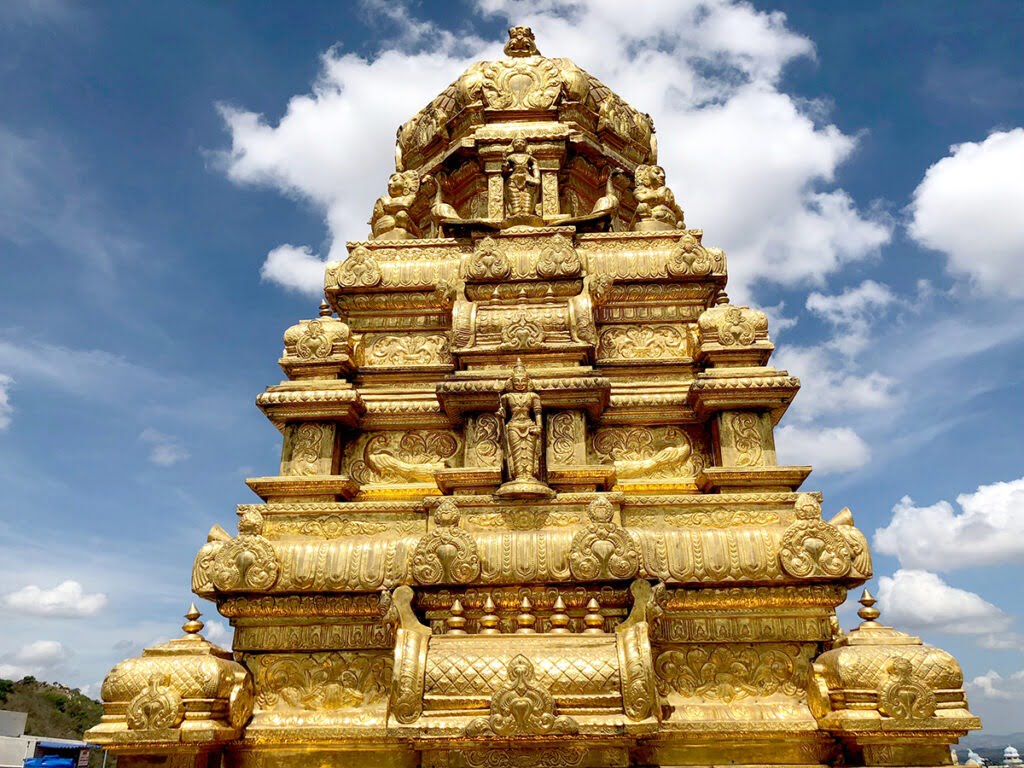Subramanya Swamy Temple at Tiruttani
Subramanya Swamy Temple at Tiruttani is a renowned Hindu temple located in Tiruttani, a town in the Tiruvallur district of Tamil Nadu, India. The temple is dedicated to Lord Murugan (also known as Subramanya or Kartikeya), the son of Lord Shiva and Goddess Parvati. It is one of the Six Abodes of Murugan, known as “Arupadai Veedu.”

Contents
- 1 History – Who made the temple of Tiruttani?
- 2 What is the Speciality of Subramanya Swamy Temple at Tiruttani?
- 3 What is the timing of Tiruttani darshan?
- 4 6 Places to visit near Tiruttani Murugan Temple:
- 5 You may also like to check other temples:
- 6 FAQ:
- 6.1 Q: Where is Thiruthani Murugan Temple located?
- 6.2 Q: When was Thiruthani Murugan Temple built?
- 6.3 Q: What is the significance of Thiruthani Murugan Temple?
- 6.4 Q: What are the main deities worshipped at Thiruthani Murugan Temple?
- 6.5 Q: What are the festivals celebrated at Thiruthani Murugan Temple?
- 6.6 Q: What are the timings of Thiruthani Murugan Temple?
- 6.7 Q: What is the dress code for visiting Thiruthani Murugan Temple?
- 6.8 Q: Are there any special rules or regulations for visiting Thiruthani Murugan Temple?
- 6.9 Q: Where can I stay near Thiruthani Murugan Temple?
- 6.10 Q: Where can I eat near Thiruthani Murugan Temple?
- 6.11 Q: How can I get to Thiruthani Murugan Temple?
- 7 Additional FAQ:
- 8 How to reach the temple:
- 9 Google Maps:
History – Who made the temple of Tiruttani?
The Subramanya Swamy Temple at Tiruttani, also known as Thiruthani Murugan Temple, is a significant Hindu temple dedicated to Lord Murugan. It is located in Tiruttani, a town in the Tiruvallur district of Tamil Nadu, India. The temple is situated on a hill called Swamimalai, and it is considered one of the Six Abodes of Murugan, known as “Aarupadai Veedu.”
The history of the Subramanya Swamy Temple is associated with various legends and myths. According to Hindu mythology, after the celestial wedding of Lord Murugan (Subramanya) with Devasena, his divine consort, the divine couple decided to visit the abodes of Lord Shiva and Goddess Parvati. As they were descending from the heavens, Lord Murugan noticed a divine hill and was instantly captivated by its beauty. He requested Lord Shiva and Goddess Parvati to bless the hill as his own abode.
It is believed that Lord Murugan assumed the role of the commander of the celestial army (Devas) and settled in Tiruttani, choosing it as his sacred dwelling place. The hill on which the temple is located is said to be the place where Lord Murugan rested after vanquishing the demon Surapadman.
Subramanya Swamy Temple at Tiruttani history can be traced back to ancient times, and it has been mentioned in several ancient Tamil texts and scriptures. It has undergone various renovations and expansions under the patronage of different ruling dynasties, including the Pallavas, Cholas, and Vijayanagara Empire.
The architecture of the Subramanya Swamy Temple showcases a blend of Dravidian and Vijayanagara architectural styles. The temple complex comprises multiple halls, shrines, and towers. The main shrine houses the idol of Lord Murugan, depicted with six faces and twelve hands, symbolizing his divine attributes and powers. The idol is believed to be swayambhu (self-manifested).
The temple is a popular pilgrimage site, and it attracts a large number of devotees throughout the year, especially during the festival of Skanda Sashti. Skanda Sashti is a six-day festival celebrated in the Tamil month of Aippasi (October-November) to commemorate the victory of Lord Murugan over the demon Surapadman.

What is the Speciality of Subramanya Swamy Temple at Tiruttani?
Location: The temple is located in the town of Tiruttani in the Tiruvallur district of Tamil Nadu, India. It is situated on a hill called Swamimalai, which is one of the six battlefields where Lord Murugan defeated the demon Surapadman.
Mythological Significance: According to Hindu mythology, it is believed that Lord Murugan married Valli, a tribal girl, at Tiruttani after winning her heart. The temple commemorates this divine marriage and is considered a sacred place for devotees seeking blessings for a happy married life.
Arupadai Veedu: The Subramanya Swamy Temple at Tiruttani is one of the six Arupadai Veedu temples dedicated to Lord Murugan. These six temples are believed to be the places where Lord Murugan resided and performed various divine deeds during his battle against evil forces.
Steps and Gopuram: The temple complex is situated on a hill, and devotees have to climb a series of steps to reach the main shrine of Lord Murugan. The steps, known as “Sopanam,” are considered sacred and are believed to bring blessings and fulfillment of wishes. The temple’s Gopuram (gateway tower) is adorned with intricate carvings and sculptures depicting various mythological stories.
Poojas and Festivals: Subramanya Swamy Temple at Tiruttani is known for its vibrant festivals and rituals. Special poojas and abhishekams (ritualistic bathing of the deity) are performed daily. The Kanda Shasti festival, dedicated to Lord Murugan, is celebrated with great enthusiasm and devotion. It spans six days and involves various ceremonies, including processions, music, dance, and reenactments of mythological events.
Valli Deivanai Temple: Adjacent to the main temple of Subramanya Swamy, there is a separate shrine dedicated to Valli Deivanai, the consorts of Lord Murugan. Devotees visit this shrine to seek blessings for a prosperous and harmonious marital life.
Scenic Beauty: The temple’s hilltop location offers breathtaking views of the surrounding landscape, including lush greenery, valleys, and hills. It provides a serene and peaceful environment for devotees to engage in prayer and meditation.

What is the timing of Tiruttani darshan?
Morning Timings:
5:30 AM to 6:00 AM – Vishwaroopa Darshan
6:00 AM to 8:00 AM – Suprabhatha Darshan
8:00 AM to 1:00 PM – Darshan for Devotees
Afternoon Timings:
1:00 PM to 1:30 PM – Uchikala Puja
1:30 PM to 4:30 PM – Darshan for Devotees
Evening Timings:
4:30 PM to 5:00 PM – Sayaratchai Puja
5:00 PM to 9:00 PM – Darshan for Devotees
Note: Subramanya Swamy Temple at Tiruttani timings may vary on special occasions, festivals, and during the Tamil month of Margazhi (mid-December to mid-January) when the temple celebrates the annual “Margazhi Brahmotsavam” festival.
6 Places to visit near Tiruttani Murugan Temple:
Nagalapuram: Situated around 40 kilometers, Nagalapuram is a village known for its historic temples. The Nagalapuram Venkateswara Temple and Nagalapuram Waterfalls are popular attractions here.
Uthukottai: Uthukottai is a small town located about 17 kilometers. It is known for its scenic beauty and has a beautiful lake called Uthukottai Eri. The lake is surrounded by lush greenery and is a popular picnic spot.
Kailasakona Waterfalls: Kailasakona Waterfalls is located approximately 70 kilometers. It is a natural waterfall surrounded by a dense forest. The area is serene and offers a peaceful atmosphere.
Vedanthangal Bird Sanctuary: Situated around 60 kilometers, Vedanthangal Bird Sanctuary is one of the oldest bird sanctuaries in India. It is home to a variety of migratory birds and is a paradise for birdwatchers.
Pulicat Lake: Pulicat Lake is a brackish water lagoon located about 85 kilometers. It is the second-largest lagoon in India and is known for its rich birdlife. The lake is a popular spot for boating and birdwatching.
Arani: Arani is a town located around 40 kilometers away. It is known for its silk-weaving industry and is a great place to buy silk sarees and fabrics.
You may also like to check other temples:
Srisailam Bhramaramba Mallikarjuna Swamy Temple and
Prabhas Shakti Peeth Maa Chandrabhaga Veraval.

FAQ:
Q: Where is Thiruthani Murugan Temple located?
A: Thiruthani Murugan Temple is located in Thiruthani, a town in Thiruvallur district, Tamil Nadu, India. It is about 72 kilometers from Chennai and 68 kilometers from Tirupati.
Q: When was Thiruthani Murugan Temple built?
A: Thiruthani Murugan Temple is believed to have been built in the 6th century AD by the Pallava king, Mahendravarman I. It was later renovated by the Chola, Pandya, and Vijayanagara kings.
Q: What is the significance of Thiruthani Murugan Temple?
A: Thiruthani Murugan Temple is one of the six most sacred Abodes of Murugan, also known as Arumugam or Subramanya. It is also one of the Pancha Bootha Sthalams, or five elemental temples of Murugan, representing the element of fire.
Q: What are the main deities worshipped at Thiruthani Murugan Temple?
A: The main deity worshipped at Thiruthani Murugan Temple is Murugan, also known as Arumugam or Subramanya. He is worshipped in the form of a Swayambumurthi, or self-manifested idol. The temple also houses shrines to various other deities, including Valli, Deivanai, Vinayaka, and Ganesha.
Q: What are the festivals celebrated at Thiruthani Murugan Temple?
A: The main festivals celebrated at Thiruthani Murugan Temple are the Skanda Shashti festival in October-November, the Vaikasi Visakam festival in May-June, and the Thai Poosam festival in January-February.
Q: What are the timings of Thiruthani Murugan Temple?
A: Thiruthani Murugan Temple is open from 6:00 AM to 12:00 PM and from 4:00 PM to 8:00 PM.
Q: What is the dress code for visiting Thiruthani Murugan Temple?
A: Devotees are advised to wear decent clothing when visiting Thiruthani Murugan Temple. Men are advised to wear dhotis or kurtas, and women are advised to wear sarees or salwar kameez.
Q: Are there any special rules or regulations for visiting Thiruthani Murugan Temple?
A: Devotees are not allowed to wear footwear inside the temple. They are also not allowed to take photographs or videos inside the temple.
Q: Where can I stay near Thiruthani Murugan Temple?
A: There are a number of hotels and guesthouses located near Thiruthani Murugan Temple. Devotees can also stay at the temple’s own guest house.
Q: Where can I eat near Thiruthani Murugan Temple?
A: There are a number of restaurants located near Thiruthani Murugan Temple serving both vegetarian and non-vegetarian food. Devotees can also eat at the temple’s own canteen.
Q: How can I get to Thiruthani Murugan Temple?
A: Thiruthani Murugan Temple is well-connected by road, rail, and air. Devotees can take a taxi or bus from Chennai or Tirupati. They can also fly to Chennai Airport or Tirupati Airport and take a taxi or bus to the temple.

Additional FAQ:
Q: What is the significance of the Thiruthani Murugan Temple?
A: Thiruthani Murugan Temple is one of the six most sacred Abodes of Murugan, also known as Arumugam or Subramanya. It is also one of the Pancha Bootha Sthalams, or five elemental temples of Murugan, representing the element of fire.
Q: What is special about Thiruthani Murugan Temple?
A: Thiruthani Murugan Temple is famous for its 365 steps leading up to the temple. These steps represent the 365 days of the year. Devotees climb the steps as an act of penance and to seek the blessings of Murugan.
Q: What are the benefits of visiting Thiruthani Murugan Temple?
A: Devotees believe that visiting Thiruthani Murugan Temple can bring them good health, prosperity, and success. The temple is also a popular pilgrimage destination for those seeking Murugan’s blessings for marriage and childbirth.
How to reach the temple:
By Air:
The nearest airport to Subramanya Swamy Temple at Tiruttani is Chennai International Airport, located approximately 76 kilometers away. From the airport, you can hire a taxi or take a bus.
By Train:
Tiruttani has its own railway station, Tiruttani Railway Station, which is well-connected to major cities in Tamil Nadu and other parts of the country. You can check for trains that pass through Tiruttani and plan your journey accordingly.
By Road:
Subramanya Swamy Temple at Tiruttani is well-connected by road and can be easily accessed by buses, taxis, or private vehicles. Here are a few options:
From Chennai: Subramanya Swamy Temple at Tiruttani is located about 76 kilometers from Chennai. You can take a bus or hire a taxi from Chennai. The journey takes around 2-3 hours, depending on the traffic.
From Tirupati: It is approximately 45 kilometers from Tirupati. You can take a bus or hire a taxi from Tirupati. The journey takes about 1-2 hours.
From Vellore: Temple is around 83 kilometers from Vellore. You can take a bus or hire a taxi from Vellore. The journey takes approximately 2-3 hours.
Local Transport:
Once you reach Tiruttani, you can easily find local transportation options such as auto-rickshaws or cycle rickshaws to reach the Subramanya Swamy Temple. The temple is located on a hill, and there are steps leading to the shrine. You can climb the steps or use the pathway to reach the Subramanya Swamy Temple at Tiruttani.
It’s advisable to check the current transportation options and schedules as they may vary based on the time of your visit.
